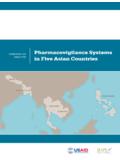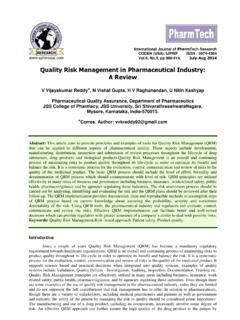Transcription of PATIENT MONITORING GUIDELINES FOR HIV …
1 PATIENT MONITORING . GUIDELINES FOR. HIV CARE AND. ANTIRETROVIRAL. THERAPY (ART). world health organization ISBN 92 4 159388 1. Department of HIV/AIDS. 20, avenue Appia CH-1211 Geneva 27. Switzerland E-mail: WHO Library Cataloguing-in-Publication Data PATIENT MONITORING GUIDELINES for HIV care and antiretroviral therapy (ART). 1. HIV infections - drug therapy. 2. Acquired immunode ciency syndrome - drug therapy. 3. Drug MONITORING . 4. Anti-retroviral agents - administration & dosage. 5. GUIDELINES . I. world health organization . ISBN 92 4 159388 1 (NLM classi cation: WC ). world health organization 2006. All rights reserved.
2 Publications of the world health organization can be obtained from WHO Press, world health organization , 20 Avenue Appia, 1211 Geneva 27, Switzerland (tel: +41 22 791 2476; fax: +41 22 791 4857;. email: Requests for permission to reproduce or translate WHO publications whether for sale or for noncommercial distribution should be addressed to WHO Press, at the above address (fax: +41 22 791 4806; email: The designations employed and the presentation of the material in this publication do not imply the expression of any opinion whatsoever on the part of the world health organization concerning the legal status of any country, territory, city or area or of its authorities, or concerning the delimitation of its frontiers or boundaries.))
3 Dotted lines on maps represent approximate border lines for which there may not yet be full agreement. The mention of speci c companies or of certain manufacturers' products does not imply that they are endorsed or recommended by the world health organization in preference to others of a similar nature that are not mentioned. Errors and omissions excepted, the names of proprietary products are distinguished by initial capital letters. All reasonable precautions have been taken by WHO to verify the information contained in this publication. However, the published material is being distributed without warranty of any kind, either express or implied.
4 The responsibility for the interpretation and use of the material lies with the reader. In no event shall the world health organization be liable for damages arising from its use. Printed in France CHAPTER TWO STANDARDIZED MINIMUM PATIENT MONITORING DATA. PATIENT MONITORING . GUIDELINES FOR. HIV CARE AND. ANTIRETROVIRAL. THERAPY (ART). 1. PATIENT MONITORING GUIDELINES FOR HIV CARE AND ANTIRETROVIRAL THERAPY (ART). LIST OF PARTICIPATING ORGANIZATIONS. These GUIDELINES reflect discussions at the WHO HIV PATIENT ART MONITORING meeting held at WHO/HQ, Geneva, Switzerland from 29-31 March 2004, and subsequent work by the subgroup reviewing the PATIENT card and registers, discussions with stakeholders, initial ART PATIENT MONITORING experience, and further expert input.
5 This document is a work in progress and will evolve in part determined by country experience and other relevant developments. AIDS Institute, New York, USA. Department of Disease Control, Bangkok, Thailand EPICENTRE/M decins Sans Fronti res, France ESTHER, France Family health International, Arlington, USA. Global Fund to Fight AIDS, TB and Malaria, Geneva, Switzerland Infectious Diseases Institute, Kampala, Uganda John Snow Inc/DELIVER, Kenya Lighthouse, Malawi Management Sciences for health /Rational Pharmaceutical Management Plus, Arlington, USA. MCART Association, Geneva, Switzerland MEASURE Evaluation, Arlington, USA.
6 MTCT-Plus Initiative, Columbia University, New York, USA. Office of the United States Global AIDS Coordinator, USA. Pan African Treatment Access Movement, Egypt Partners In health , Boston, USA. PHARMA ccess, Netherlands SATELLIFE, Watertown, USA. St Camille Medical Centre, Burkina Faso United Nations Children's Fund University of Brescia, Italy University of Cape Town, South Africa United States President's Emergency Plan health and Human Services/Centers for Disease Control and Prevention health and Human Services/ health Resources and Services Administration United States Agency for International Development VOXIVA, Washington DC, USA.
7 world health organization Additional input was provided by: Chris Bailey, Eddy Beck, Dan Bleed, Andrew Boull , Siobhan Crowley, Tedd Ellerbrock, Mary Freyder, Charlie Gilks, Peter Graaff, Reuben Granich, Anthony Harries, Chika Hayashi, Lisa Hirschhorn, Holly Ladd, Stephen Lee, Varja Lipovsek, Theo Lippeveld, John Milberg, Cyril Pervilhac, Laura Porter, Tonia Poteat, Paul Pronyk, Alasdair Reid, Mark Shields, Don Sutherland, and Catherine Watt, with special thanks to the CDC and US President's Emergency Plan Treatment and Indicator Technical Workgroups. Overall coordination was provided by Sandy Gove, Francesca Celletti and Kwonjune Seung, the IMAI team in Department of HIV/AIDS, WHO/HQ and Tisha Mitsunaga, MEASURE Evaluation/JSI.
8 A Word version of the card, Excel versions of the registers and reports, and training materials for filling out the forms are available at: To request country adaptation assistance please contact the HIV helpdesk at or 2. CHAPTER TWO STANDARDIZED MINIMUM PATIENT MONITORING DATA. TABLE OF CONTENTS. List of participating organizations _____ 2. List of abbreviations_____ 5. Chapter One HIV PATIENT care and ART information systems _____ 7. A. Objectives and intended audience _____ 8. B. PATIENT MONITORING within efforts to scale up HIV care, ART and prevention _____ 9. C. Both PATIENT and programme MONITORING _____ 11.
9 D. organization of the GUIDELINES _____ 12. E. How to adapt and operationalize the HIV care/ART PATIENT MONITORING system _____ 13. Chapter Two Standardized minimum PATIENT MONITORING data _____ 15. A. Essential minimum standard HIV care and ART PATIENT MONITORING data _____ 16. B. Calculating indicators from the PATIENT MONITORING data _____ 32. C. Paediatric indicators _____36. D. Relationship to standardized TB MONITORING and the new TB/HIV indicators _____36. Chapter Three Facility-level data collection use and linkages _____39. A. Linkages with other facility-based systems _____40. B. Linking paper and electronic systems _____ 41.
10 C. Using PATIENT MONITORING data to help forecast and manage the ARV drug supply _ 45. D. Using PATIENT MONITORING data for pharmacovigilance _____48. E. Linkages with other MONITORING and evaluation tools _____48. Chapter Four Practical application of PATIENT MONITORING tools: generic illustrative system ___ 51. A. Introduction _____ 52. B. PATIENT card or other record _____ 53. C. Pre-ART and ART registers _____56. D. Quarterly (or monthly) facility-based HIV care/ART reporting form _____62. E. ART cohort analysis report form _____67. F. Aggregating data _____ 74. G. Alternative approaches to calculating indicators _____ 75.















